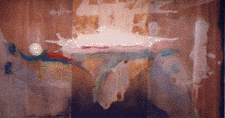MADAME BUTTERFLY:
A SPECTACULAR TRIPTYCH
BY HELEN FRANKENTHALER

·the artist is
able through her
nonobjective vocabulary to produce an image
that evokes not only a
sense
of femininity (in terms of grace and delicacy),
but also an Asian or
oriental
style (in terms of its airy atmosphere,
transparency, and all
over composition).
Helen
Frankenthaler
(born 1928) is a world-renowned abstract artist whose work heralded in
painting's next significant phase after abstract expressionism in the
1940's.
Rather than apply paint in a thick, gestural manner, Frankenthaler
chose
to stain her canvases with broad expanses of veil-like color that give
her finished works a transcendent, mystical glow. Her work is
seldom
about a distinct figure-ground relationship; instead, the expanses of
color
immerse the viewer in a space where each passage is of equal weight in
a shimmering, decentered field. Frankenthaler's early efforts
would
eventually inspire more austere approaches in the 1960's and 1970's,
where
painters would suppress painterly gesture even further to focus solely
on color relationships.
Frankenthaler's Madame
Butterfly, a woodcut triptych printed in 2000, is a large work (41
3/4 x 79 1/2 inches) of remarkable complexity. The triptych
is Frankenthaler's last print in collaboration with master printer
Kenneth
Tyler, founder of the famed Tyler Graphics studio. Under his
expert
technical supervision, the artist and the Tyler technicians employed
traditional
Japanese ukiyo-e carving and registering techniques to print 102 colors
on elegant sheets of handmade paper made exclusively for this
edition.
The resulting work reminds one of Japanese prints, where the fluid
lines
belie the physical force required to carve a woodblock's surface.
Frankenthaler's abstract shapes of misty color fade from one to the
other
in a manner that reminds one of watercolor effects.
The title
Madame
Butterfly works with the image in a poetic way. The opera Madame
Butterfly is primarily about the experiences of a Japanese woman;
the
artist is able through her nonobjective vocabulary to produce an image
that evokes not only a sense of femininity (in terms of grace and
delicacy),
but also an Asian or oriental style (in terms of its airy atmosphere,
transparency,
and all over composition). The work also relates metaphorically
to
opera in general. That is, the techniques used in both the
woodcut
and opera singing are sophisticated and difficult to master, yet both
the
sound of the singing and the appearance of the print strike a listener
or viewer as simply and effortlessly beautiful.
In
addition,
the centralized white shape, with its wing-like spread and rounded
projections,
does in fact look rather like a butterfly. The shape is certainly
not literal or illustrative; a direct representation would be
disappointing
and would spoil the mystery. Rather, the various forms in the
triptych
float on gossamer wings like the essence of the insect, amid soft,
tissue-like
tones and a variety of natural textures.
Helen
Frankenthaler's Madame
Butterfly is impressive in its visual and conceptual depth.
The
woodcut, a recent acquisition of Valparaiso University's Brauer Museum
of Art, is a spectacular example and summary of the artist's pictorial
concerns over the last half century. Its addition to the Brauer
Museum
of Art's permanent collection is an event truly worthy of celebration.
© by Gregg Hertzlieb



![]()
![]()
![]()
![]()